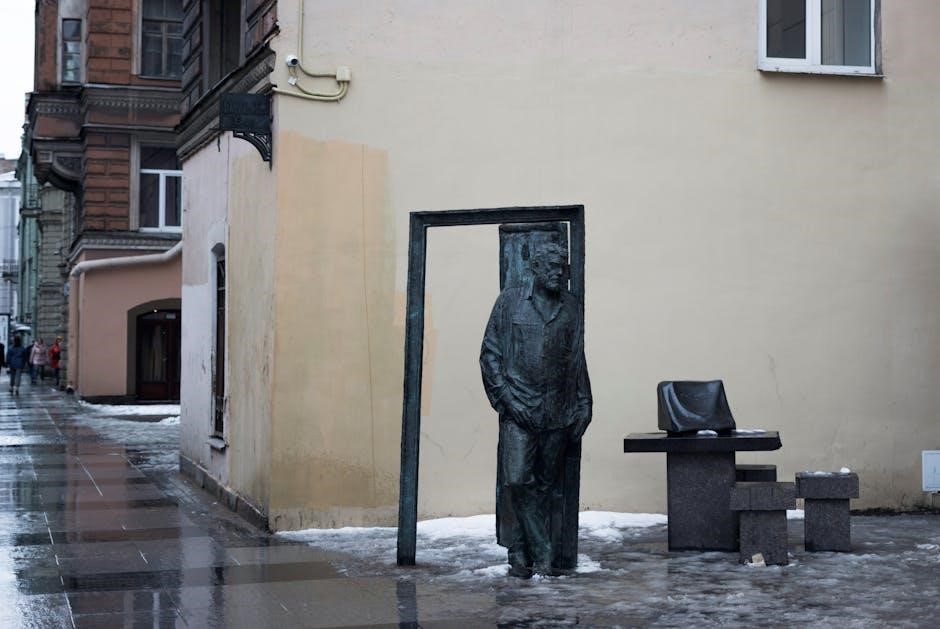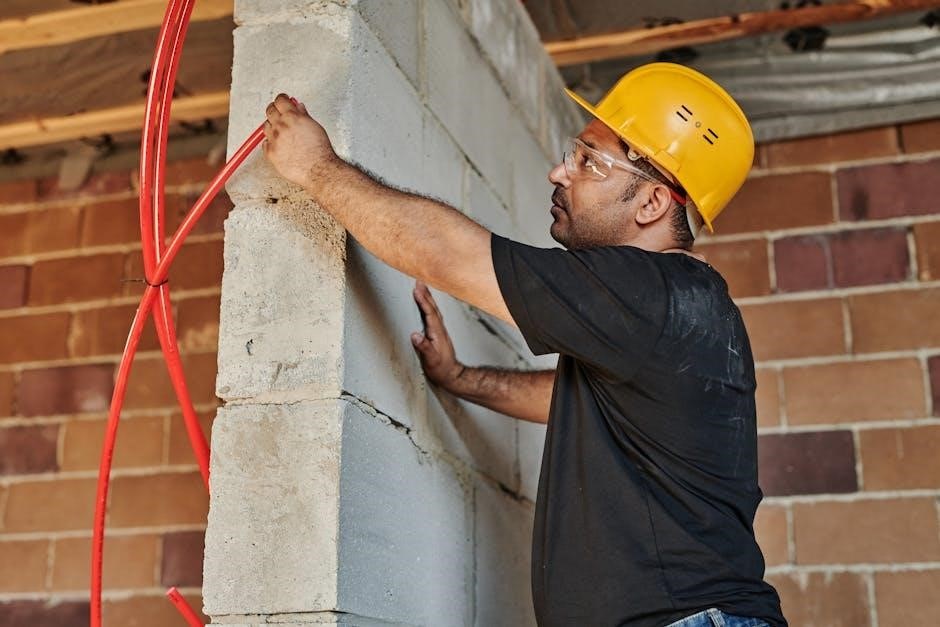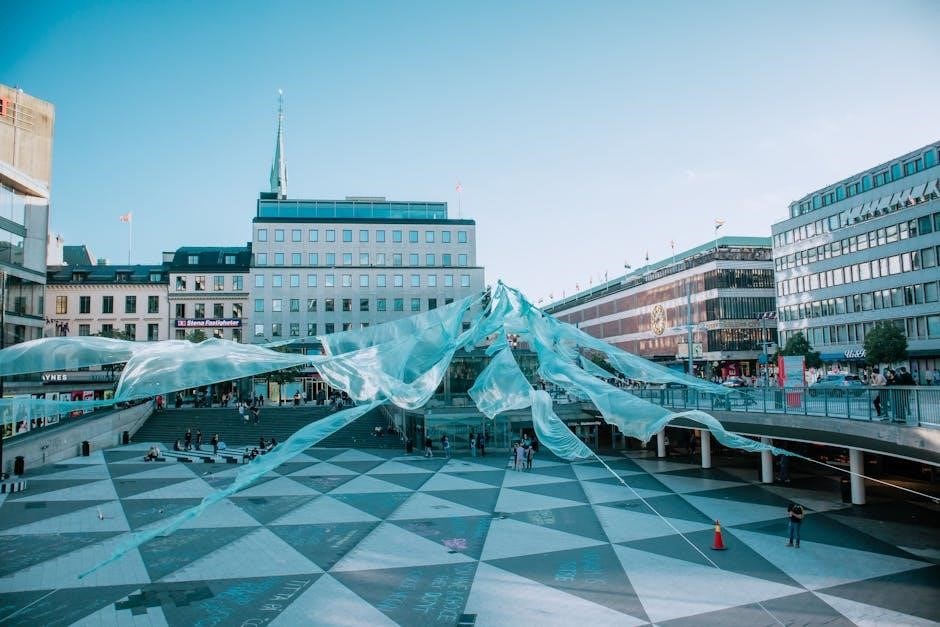Villaboard is a durable, moisture-resistant lining board ideal for wet areas like bathrooms and laundries. Its unique design provides a stable surface for tiling or finishing, ensuring longevity and aesthetic appeal. Proper installation in wet areas requires careful planning and adherence to specific guidelines to prevent water damage and ensure structural integrity. This guide will walk you through the essential steps and considerations for a successful Villaboard installation in wet areas.
1.1 Overview of Villaboard and Its Suitability for Wet Areas
Villaboard is a durable, moisture-resistant lining board designed for internal wet areas such as bathrooms, laundries, and kitchens. Its composition makes it highly suitable for environments exposed to water, offering excellent resistance to moisture and impact. The board’s smooth surface provides an ideal base for tiling, painting, or wallpapering, while its recessed edges enable seamless flush-jointing for a professional finish. Villaboard’s ability to withstand wet conditions without compromising structural integrity makes it a popular choice for homeowners and builders seeking reliable and long-lasting solutions for wet area applications.
1.2 Importance of Proper Installation in Wet Areas
Proper installation of Villaboard in wet areas is crucial to prevent water damage and ensure long-term durability; Incorrect methods can lead to water penetration, resulting in costly repairs and potential structural issues. A well-executed installation ensures a watertight seal, protecting both the Villaboard and the surrounding structure. Additionally, proper techniques guarantee a smooth, even surface for finishes like tile or paint. By following manufacturer guidelines and best practices, installers can achieve a professional result that withstands the demands of wet environments, maintaining the integrity and appearance of the area for years to come.

Preparation Before Installation
Preparation is key for Villaboard installation. Assess substrate, select materials, plan layout, and ensure tools are ready. A well-prepared site ensures smooth installation.
2.1 Assessing the Substrate for Villaboard
Before installing Villaboard, assess the substrate to ensure it is level, dry, and structurally sound. Check for any cracks or unevenness. Clean the surface thoroughly, removing old adhesives or debris. For wet areas, ensure the substrate is compatible with waterproofing membranes. If necessary, apply a leveling compound. Verify that all electrical and plumbing components are in place and secure. A stable and even base is crucial for a successful installation and to prevent future issues.
2.2 Selecting the Right Materials and Tools
Selecting the right materials and tools is essential for a successful Villaboard installation in wet areas. Use Villaboard sheets designed for wet areas, ensuring they are moisture-resistant and durable. Stainless steel nails or screws are recommended for wet area applications to prevent rust. Additionally, gather necessary tools such as a measuring tape, pencil, utility knife, drill, and trowel for applying waterproofing membranes. A spirit level and rubber mallet will help ensure panels are straight and securely fastened. Always use a compatible adhesive for bonding Villaboard to the substrate. A notched trowel is ideal for applying waterproofing compounds evenly. Safety gear, like gloves and goggles, is also crucial.
Step-by-Step Installation Process
The Villaboard installation process involves starting from the ceiling and working downwards, ensuring panels are properly aligned and secured. Use appropriate materials and apply waterproofing correctly. Keep surfaces level and plumb throughout.
3.1 Starting from the Ceiling Down to the Floor
Begin by measuring and marking the ceiling to determine where the Villaboard panels will start. Working downward ensures proper alignment and minimizes cutting errors. Use a laser level for accuracy. Secure panels firmly to the substrate, starting at the top and progressing to the floor. This method helps maintain straight lines and prevents water from pooling behind the boards; Ensure panels are plumb and level as you proceed. Secure each panel with appropriate fasteners, such as stainless steel nails for wet areas, to ensure durability and water resistance. This approach guarantees a smooth, professional finish ready for tiling or other finishes.
3.2 Installing Villaboard Around Perimeter and Edges
When installing Villaboard around the perimeter and edges, ensure panels fit snugly against walls and corners. Use a utility knife or saw to cut panels precisely, leaving a 10mm gap around edges for expansion. Secure panels with fasteners, maintaining a 150mm spacing between them. For corners, use corner beads to reinforce edges and achieve a smooth finish. Apply a bead of waterproof sealant in gaps and joints to prevent moisture intrusion. This step ensures a watertight seal and prepares the surface for tiling or other finishes, maintaining durability in wet areas.
3.3 Joining Villaboard Panels Flush

Flush joints are critical for a seamless installation in wet areas. Align panels edge-to-edge, ensuring they are level and plumb. Use a rubber mallet to tap panels into place, avoiding direct hammering. Apply a bead of waterproof sealant along the joint before securing with fasteners. For added strength, install joint beads or H-sections, ensuring they are flush with the panel surface. Properly sealed flush joints prevent water penetration and enhance the overall durability of the Villaboard system in wet environments. Always follow manufacturer guidelines for joint preparation and sealing to maintain warranty and performance standards.
3.4 Cutting Villaboard Panels for a Perfect Fit
Cutting Villaboard panels accurately ensures a professional finish and proper fit in wet areas; Use a utility knife or circular saw with a carbide blade for straight cuts. Score deeply, then snap the panel along the line for a clean edge. For curved cuts, a jigsaw is recommended. Always wear protective gear and work in a well-ventilated area. After cutting, seal raw edges with a waterproof sealant to maintain moisture resistance. Measure carefully to fit panels around pipes, fixtures, and other obstructions. Avoid overcutting, as this can weaken the panel. Precise cuts ensure a seamless installation and prevent water ingress in wet areas.

Special Considerations for Wet Areas
Wet areas require extra precautions to ensure durability and water resistance. Applying waterproof membranes, using appropriate fixing methods, and incorporating movement joints are critical for long-term performance and moisture protection.
4.1 Applying Waterproof Membranes Before Installation
Applying a waterproof membrane is essential before installing Villaboard in wet areas. This step ensures that water does not penetrate behind the lining, preventing mold and structural damage. The membrane should be applied to the substrate according to manufacturer instructions, ensuring full coverage and proper adhesion. For wet areas, it’s crucial to follow the recommendations strictly to maintain the integrity of the waterproofing system. This layer acts as a barrier, protecting both the Villaboard and the underlying structure from moisture exposure.
4.2 Fixing Methods: Nails vs. Screws for Wet Areas
In wet areas, the choice between nails and screws for fixing Villaboard is critical. Stainless steel nails are recommended for internal wet area applications to resist corrosion and ensure durability. Screws, particularly those made of corrosion-resistant materials, can also be used, especially for steel frame constructions. However, nails are generally preferred for their ease of use and effectiveness in timber studs. Regardless of the fixing method, it’s important to avoid over-tightening, as this can damage the Villaboard. Proper fixing ensures a secure and long-lasting installation, preventing issues like loosening or water infiltration over time.
4.3 Incorporating Movement Joints in Wet Areas
Movement joints are essential in wet areas to accommodate thermal and structural expansion. Villaboard installations in bathrooms and laundries must include these joints to prevent cracking and damage. Typically, movement joints should be placed at corners, around fixtures, and along perimeter walls. A bond breaker, such as a flexible sealant, should be applied between the Villaboard and surrounding structures to allow for movement. Properly incorporated movement joints ensure the longevity of the installation and maintain the integrity of the waterproofing system, preventing water seepage and structural issues over time.

Finishing Touches
Seal all gaps and joints with waterproof sealants to ensure a watertight finish. Clean the Villaboard surface thoroughly before applying tiles, paint, or other finishes for a polished look.
5.1 Sealing Gaps and Joints in Wet Areas
Sealing gaps and joints is critical to ensure water resistance in wet areas. Use a high-quality waterproof sealant, such as silicone-based products, to fill all gaps between Villaboard panels and surrounding surfaces. Apply the sealant evenly, ensuring complete coverage. Wipe off excess material immediately for a clean finish. Regularly inspect and reseal joints to maintain watertight integrity, especially in areas exposed to heavy moisture. Proper sealing prevents water infiltration and extends the lifespan of the Villaboard installation. This step is essential for safeguarding the structure and ensuring a durable, moisture-free environment in bathrooms, laundries, and other wet areas.
5.2 Cleaning and Preparing the Surface for Further Finishes
After installing Villaboard, clean the surface thoroughly to prepare it for further finishes like painting or tiling. Allow the panels to dry completely, then wipe them down with a mild detergent and water to remove any dirt or residue. Lightly sand any rough edges or joints to ensure a smooth surface. Rinse the panels thoroughly and let them dry before applying any finishes. This step ensures proper adhesion and a professional-looking result. Regular cleaning and preparation are essential for maintaining the integrity and appearance of Villaboard in wet areas, ensuring it remains a durable and long-lasting solution.
Maintenance and Longevity
Regularly inspect Villaboard in wet areas for water damage or mold. Clean surfaces with mild detergents to prevent grime buildup. Ensure good ventilation to reduce moisture exposure, and address any leaks promptly to maintain durability and prevent deterioration over time.
6.1 Tips for Maintaining Villaboard in Wet Areas
Regularly inspect Villaboard surfaces for signs of water damage or mold. Clean with mild detergents to prevent grime buildup. Ensure surfaces dry completely after cleaning. Address any leaks promptly to avoid moisture accumulation. Maintain good ventilation in wet areas to reduce humidity. Avoid using harsh chemicals that may damage the material. For tiled areas, regrout as needed to prevent water seepage. Inspect joints and edges for gaps and reseal if necessary. These practices will enhance durability and maintain the integrity of Villaboard in wet areas over time;
6.2 Addressing Common Issues Post-Installation
Common issues after Villaboard installation in wet areas include water damage, mold growth, or loose fasteners. Address leaks promptly to prevent moisture buildup. Inspect panels for cracks or gaps and reseal them with waterproof sealants. For tiled surfaces, regrout as needed to maintain water tightness. Check fasteners and tighten any loose screws or nails. Clean surfaces regularly to prevent mildew. If mold appears, treat with mildew-resistant cleaners. Ensure proper ventilation to reduce humidity. Regular inspections can help identify and resolve issues early, ensuring the longevity of Villaboard in wet areas.
Proper installation and maintenance of Villaboard in wet areas ensure durability and performance. By following guidelines, selecting the right materials, and addressing potential issues promptly, you can create a long-lasting, water-resistant surface. Regular inspections, cleaning, and repairs are crucial for maintaining integrity. Villaboard’s suitability for wet areas, combined with correct techniques, makes it an excellent choice for bathrooms, laundries, and similar spaces. With attention to detail and adherence to best practices, your Villaboard installation will provide years of reliable service, supporting your home’s functionality and aesthetic appeal.
